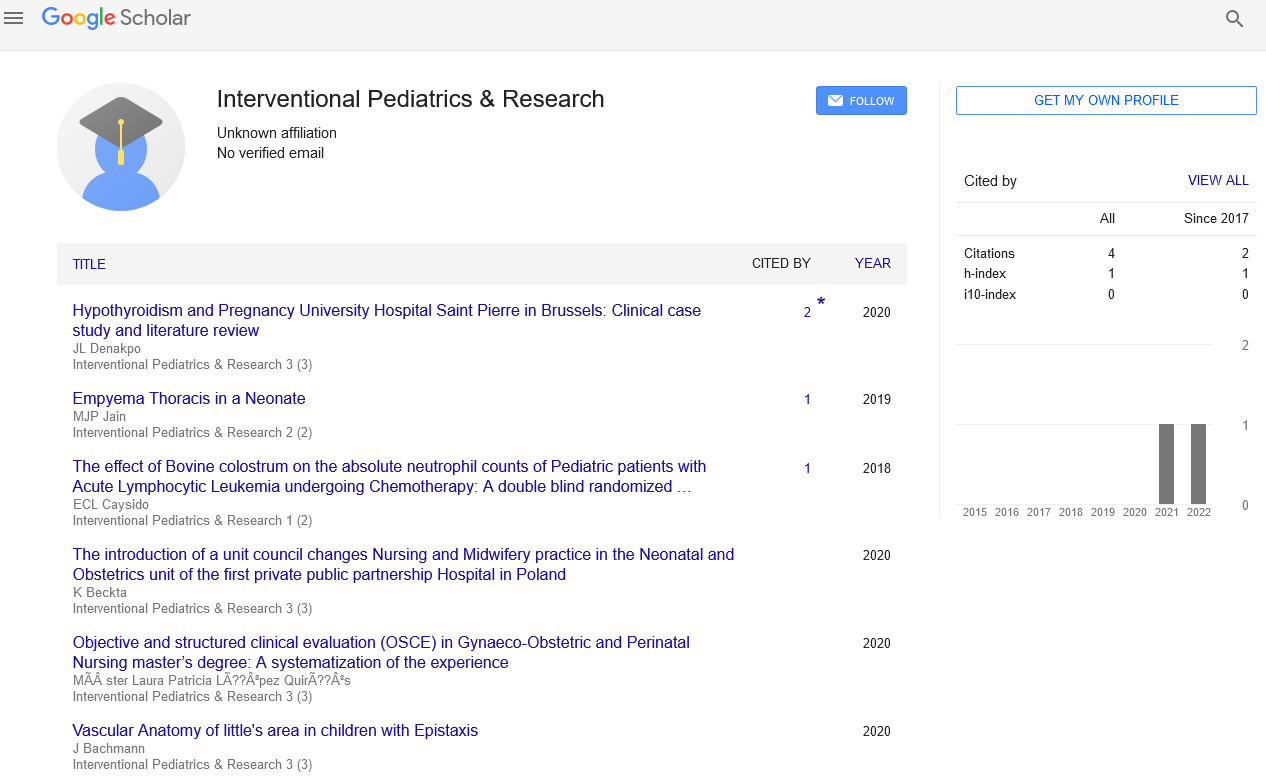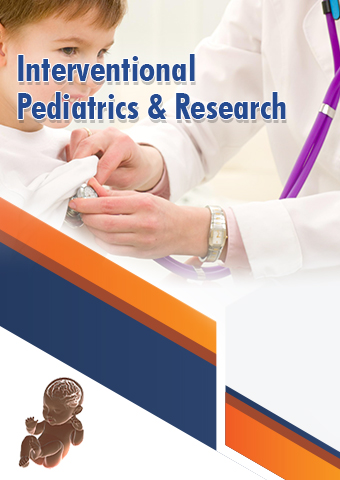Review Article - Interventional Pediatrics & Research (2023) Volume 6, Issue 2
Pediatric Cardiology Interventions: Managing Heart Conditions in Children
Marcus Anderson*
Department of Pediatric cardiology interventions, Australia
Department of Pediatric cardiology interventions, Australia
E-mail: Anderson_m5@gmail.com
Received: 01-April-2023, Manuscript No. ipdr-23-96055; Editor assigned: 03-April-2023, Pre-QC No. ipdr-23- 96055 (PQ); Reviewed: 18-April-2023, QC No. ipdr-23-96055; Revised: 24-April-2023, Manuscript No. ipdr-23-96055 (R); Published: 28-April-2023, DOI: 10.37532/ ipdr.2023.6(2).28-30
Abstract
Pediatric cardiology interventions are medical procedures used to diagnose and treat heart conditions in children. These interventions are crucial for managing congenital heart defects, arrhythmias, and acquired heart diseases. Surgical interventions, such as openheart surgery and minimally invasive techniques, are commonly used to manage heart defects. Non-invasive interventions, such as medications and lifestyle changes, may also be recommended. For arrhythmias, catheter ablation is a common intervention that has a high success rate and is considered safe for children. With early diagnosis and appropriate treatment, many children with heart conditions can go on to live healthy, active lives.
Keywords
Pediatric • Cardiology • Interventions • Congenital heart defects • Arrhythmias •Acquired heart diseases • Open-heart surgery • Minimally invasive techniques • Catheter ablation • Medications • Lifestyle changes
Introduction
Pediatric cardiology interventions refer to medical procedures used to diagnose and treat heart conditions in infants, children, and adolescents [1]. These interventions are crucial for managing a range of heart diseases that can affect children, including congenital heart defects, arrhythmias, and acquired heart diseases. Congenital heart defects (CHD) are the most common heart conditions in children, affecting around 1 in 100 births. CHD occurs when the heart and blood vessels don’t form correctly during fetal development. This can cause abnormal blood flow, which can lead to heart failure, growth problems, and other complications. Pediatric cardiology interventions are vital in managing CHD, as these defects often require immediate surgical intervention [2]. One of the most common interventions for CHD is open-heart surgery. In this procedure, the surgeon makes an incision in the chest to access the heart and repair the defect. In some cases, minimally invasive techniques may be used, such as small incisions or catheterbased procedures [3]. These procedures are less invasive and may have a shorter recovery time. In addition to surgical interventions, other non-invasive interventions can help manage CHD. For example, medications such as diuretics, ACE inhibitors, and beta-blockers may be prescribed to help manage heart function and reduce the risk of complications. Lifestyle changes, such as dietary modifications and exercise programs, may also be recommended to help manage the condition [4]. Arrhythmias are another common heart condition in children, characterized by abnormal heart rhythms. These conditions can be caused by a range of factors, including structural heart defects, medication side effects, and genetic conditions. Pediatric cardiology interventions for arrhythmias may include medications, electrical therapies, and surgical procedures. One of the most common interventions for arrhythmias is catheter ablation. This procedure involves the insertion of a catheter into the heart through a small incision [5]. The catheter is guided to the area of the heart where the arrhythmia is occurring, and radiofrequency energy is used to destroy the tissue that is causing the abnormal rhythm. This procedure has a high success rate and is considered safe for children. Acquired heart diseases, such as rheumatic fever and Kawasaki disease, can also affect children. These conditions can cause inflammation of the heart and lead to damage to the heart muscle or valves [6]. Pediatric cardiology interventions for acquired heart diseases may include medications, surgery, or other therapies. In conclusion, pediatric cardiology interventions play a critical role in managing a range of heart conditions in children. These interventions may include surgical procedures, medications, lifestyle changes, and other therapies. With early diagnosis and appropriate treatment, many children with heart conditions can go on to live healthy, active lives. If you suspect that your child may have a heart condition, it’s important to seek medical attention promptly to ensure the best possible outcome [7].
Pediatric Cardiology Interventions for Congenital Heart Defects
Pediatric cardiology interventions for congenital heart defects (CHD) are medical procedures used to manage heart defects that develop during fetal development [8]. The interventions include surgical, minimally invasive, and non-invasive techniques, as described below
Open-Heart Surgery
This procedure involves making an incision in the chest to access the heart and repair the defect. This intervention is commonly used for complex heart defects that require immediate surgical intervention.
Pediatric Cardiology Interventions for Arrhythmias
Pediatric Cardiology Interventions for Arrhythmias are medical procedures used to manage heart rhythm disorders in children [9]. Arrhythmias are abnormal heart rhythms that can occur in children with underlying heart conditions or as a result of other medical conditions. Pediatric cardiologists may recommend the following interventions to manage arrhythmias
Catheter Ablation
This is a minimally invasive procedure that involves inserting a catheter into the heart to locate and destroy the abnormal heart tissue that causes the arrhythmia. The procedure has a high success rate and is considered safe for children.
Medications
Various medications may be prescribed to manage arrhythmias, including beta-blockers, calcium channel blockers, and anti-arrhythmic drugs [10]. The choice of medication depends on the type and severity of the arrhythmia.
Electrical Therapies
In some cases, electrical therapies such as cardio version or implantable cardioverter-defibrillator (ICD) may be recommended to manage arrhythmias. Cardio version is a procedure that uses electrical shocks to restore normal heart rhythm, while an ICD is a device that monitors and corrects abnormal heart rhythms.
Conclusion
Pediatric cardiology interventions are critical for managing heart conditions in children, including congenital heart defects, arrhythmias, and acquired heart diseases. These interventions range from minimally invasive catheter-based procedures to open-heart surgeries, medications, and lifestyle changes. The choice of intervention depends on the type and severity of the heart condition, and a pediatric cardiologist will assess the child’s condition and recommend the appropriate intervention. With early diagnosis and appropriate treatment, many children with heart conditions can go on to live healthy, active lives. It is important for parents and caregivers to be aware of the signs and symptoms of heart conditions in children and seek medical attention promptly if they suspect a problem. In conclusion, pediatric cardiology interventions play a vital role in managing heart conditions in children. With on-going research and advancements in technology, these interventions continue to improve, providing better outcomes for children with heart conditions.
References
- Ratcliffe J, Couzner L, Flynn T et al. Valuing Child Health Utility 9D health states with a young adolescent sample. Appl Health Econ Health Policy.9, 15–27 (2011).
- Brunner HI, Maker D, Grundland B et al. Preference-based measurement of health related quality of life (HRQL) in children with chronic musculoskeletal disorders (MSKD).Med Decis Making.23, 314–22 (2003).
- Sung L, Young NL, Greenberg ML et al. Health-related quality of life (HRQL) scores reported from parents and their children with chronic illness differed depending on utility elicitation method. J Clin Epidemiol.57, 1161–1166 (2004).
- Fluchel M, Horsman JR, Furlong W et al. Self and proxy-reported health status and health-related quality of life in survivors of childhood cancer in Uruguay. Pediatr Blood Cancer. 50, 838–43 (2008).
- Pal DK. Quality of life assessment in children: a review of conceptual and methodological issues in multidimensional health status measures. J Epidemiol Community Health. 50, 391–396 (1996).
- Ungar WJ, Mirabelli C, Cousins M et al. A qualitative analysis of a dyad approach to health-related quality of life measurement in children with asthma. Soc Sci Med. 63, 2354–2366 (2006).
- Varni JW, Burwinkle TM, Rapoff MA et al. The PedsQL in pediatric asthma: reliability and validity of the Pediatric Quality of Life Inventory generic core scales and asthma module. J Behav Med.27, 297–318 (2004).
- Saigal S, Feeny D, Rosenbaum PJ et al. Self-perceived health status and health-related quality of life of extremely low-birth-weight infants at adolescence. J Pediatr.130, 495 (1997).
- Chan KS, Mangione-Smith R, Burwinkle TM et al. Reliability and validity of the short-form generic core scales and asthma module. Med Care.43, 256–65 (2005).
- Juniper EF, O’Byrne PM, Guyatt GH et al. Development and validation of a questionnaire to measure asthma control. Eur Resp J.14, 902–7 (1999).
Indexed at, Google Scholar, Crossref
Indexed at, Google Scholar, Crossref
Indexed at, Google Scholar, Crossref
Indexed at, Google Scholar, Crossref
Indexed at, Google Scholar, Crossref
Indexed at, Google Scholar, Crossref
Indexed at, Google Scholar, Crossref
Indexed at, Google Scholar, Crossref


